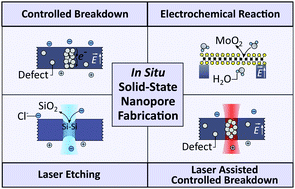In situ solid-state nanopore fabrication
Abstract
Nanopores in solid-state membranes are promising for a wide range of applications including DNA sequencing, ultra-dilute analyte detection, protein analysis, and polymer data storage. Techniques to fabricate solid-state nanopores have typically been time consuming or lacked the resolution to create pores with diameters down to a few nanometres, as required for the above applications. In recent years, several methods to fabricate nanopores in electrolyte environments have been demonstrated. These in situ methods include controlled breakdown (CBD), electrochemical reactions (ECR), laser etching and laser-assisted controlled breakdown (la-CBD). These techniques are democratising solid-state nanopores by providing the ability to fabricate pores with diameters down to a few nanometres (i.e. comparable to the size of many analytes) in a matter of minutes using relatively simple equipment. Here we review these in situ solid-state nanopore fabrication techniques and highlight the challenges and advantages of each method. Furthermore we compare these techniques by their desired application and provide insights into future research directions for in situ nanopore fabrication methods.



 Please wait while we load your content...
Please wait while we load your content...